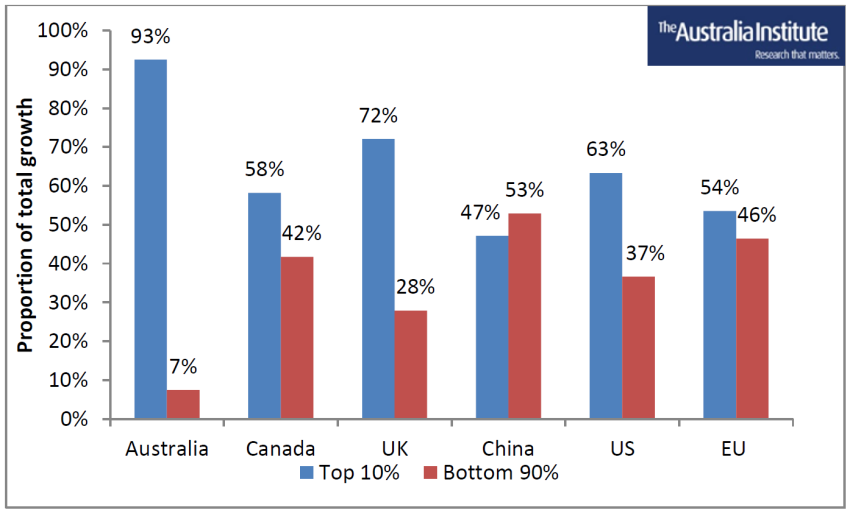
A new report released by The Australia Institute reveals that a staggering 93% of income growth over the past decade in Australia went to just the top 10% of income earners. The bottom 90% received just 7% of income growth after the global financial crisis.
The Inequality on Steroids report, by David Richardson and Matt Grudnoff, compared income equality over five periods, from 1950–2019, and found that inequality is worse than it has ever been.
The authors calculated their findings on income distribution by combining changes in real national income per adult with the share of national income going to the top 10%.
They found that economic gain in Australia is now far more concentrated compared with Canada, Britain, China, the United States and the European Union.
Between 1950 and 1960, the gains from economic growth “were enjoyed by the overwhelming majority of the Australian people”. During the post-war years, 96% of growth went to the bottom 90% and just 4% went to the top 10%.
But this all changed. From 2009 to 2019, the expansion showed “a large increase in the share going to the top 10 per cent and very little for the bottom 90 per cent”.
The contrast between the first and the final period is striking: the results are almost completely reversed.
This data sheds light on the pilfering of wealth from ordinary workers by the richest 10%. It also accounts for the serious, systematic underfunding of public utilities, which has put immense pressure on working people.
“These outcomes reflect much deeper forces, such as the concentration of Australian businesses into oligopolies and the weakening of unions in the Australian labour market,” Richardson and Grudnoff wrote.
They also note the international trend of wealth concentration, with a majority of new economic growth going to the top 10% in Canada, Britain, the US and the EU.
China was the outlier, where economic gains over 2010–2019 were split almost evenly between the top 10% and bottom 90%.
Australia, at 93%, is by far the worst offender, far ahead of Britain in second place (72%) and the US in third (63%).
Wages stagnated over the past decade as more money was scalped off as profits for the rich. Workers’ share of gross domestic product (GDP) dropped below 50% last year as the profit share continued to grow.
The long decline in workers’ share of GDP correlates with the Accord years, when Labor, bosses and union leaderships agreed unions would not campaign for wage rises in exchange for investment promises in childcare, welfare and health services.
The Accord’s wage restraint delivered significant profits to the capitalist class.
Another impact was a weakened and waning union membership, which allowed government and bosses to undermine hard-won rights with anti-union laws, and cap wages regardless of inflation.
Furthermore, the tax system has become less progressive, meaning that workers on lower wages pay more comparatively.
At the same time, many corporations avoid paying taxes entirely, deploying complex tax evasion schemes.
Now the Labor government is about to deliver the Coalition’s stage 3 tax cuts. More than $243 billion will be stripped from the budget over 10 years, disproportionately benefiting those on higher incomes.
These funds need to be deployed to upgrade public transport, fund the ailing health and education sectors, build thousands of new public housing units and fund the transition away from fossil fuels.
Similarly, the $368 billion for the AUKUS nuclear submarines needs to be redeployed from future wars and used to raise JobSeeker above the poverty line.
The stage 3 tax cuts and the AUKUS submarine deal were designed by the Coalition government. Rather than change course and relieve pressure on ordinary working people, Prime Minister Anthony Albanese is determined to maintain bipartisanship — while claiming he is delivering “a new form of politics”.
Green Left has been fighting for a people-powered alternative since 1991, supporting workers’ rights campaigns and countering the corporate media’s lies.
But we need your help to continue. Become a part of the fight back today by becoming a supporter from only $5 a month or donating to our 2023 Fighting Fund.